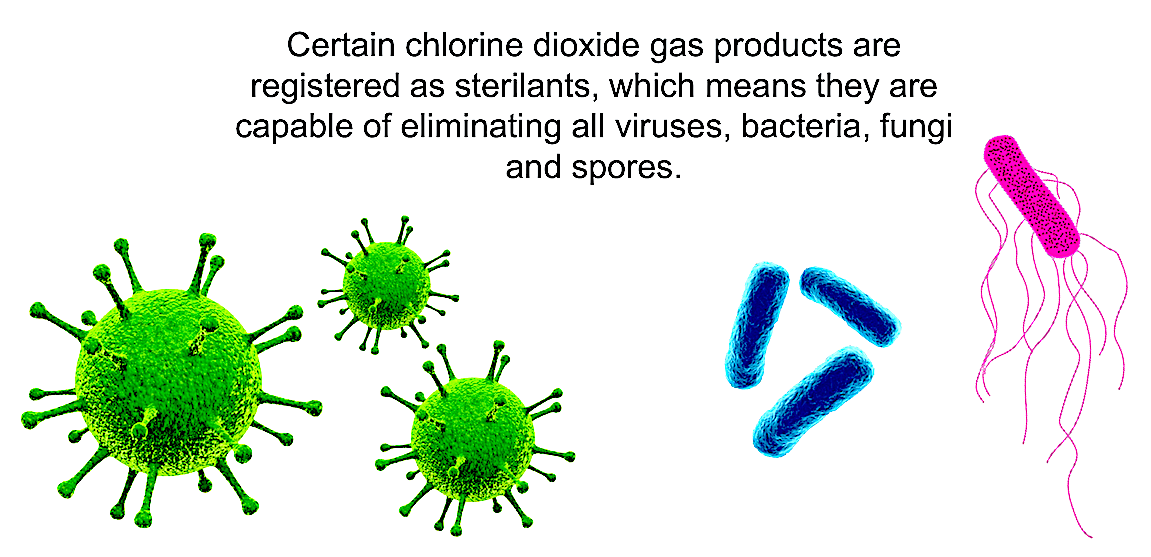.
Learn the truth about its properties, behaviors, and abilities.
Did you know that Christopher Columbus wasn’t trying to prove that the Earth was round when he set sail in 1492? Did you know that toilet water does not spin in different directions in the northern and southern hemispheres? How about that Paul Revere didn’t shout “The British are coming?” Even in this age of information, sometimes we believe in things that just aren’t true. Such is the case with chlorine dioxide. There is much confusion and conflicting information regarding its properties, behavior, and abilities. Some of the misinformation comes from old experiences, not aware that the technology has advanced. Other times it stems from misinterpretations, attributing certain outcomes to chlorine dioxide rather than the true source. Whatever the reason, it’s time to finally understand the truth about chlorine dioxide.
.
Myth: Chlorine Dioxide Corrodes Stainless Steel
This myth originated due to some commonly used liquid chlorine dioxide products. These liquid solutions are produced by mixing a base and activator which create liquid chlorine dioxide as well as chlorous acid and acidified sodium chlorite. It is these acidic byproducts which can cause corrosion of stainless steels. Chlorine dioxide itself has been shown to be compatible with stainless steel through exposure studies using the pure, gaseous form.
Myth: Chlorine Dioxide Forms Hydrochloric Acid in Water
Chlorine dioxide does not form hydrochloric acid when mixed with water.
This myth originates from the false association between chlorine and chlorine dioxide, as chlorine does form hydrochloric acid when mixed with water. Just as carbon is different than carbon dioxide, chlorine is different than chlorine dioxide. While there are similarities between chlorine and chlorine dioxide, such as their similar smell, they do have different properties. Also among their differences, chlorine dioxide gas does not deplete the ozone layer as chlorine gas does.
Water with pure chlorine dioxide in it would still have a neutral pH. Chlorine dioxide gas does not react with water and stays as chlorine dioxide within the water. This enables it to kill organisms within the water, as well as any on the surface beneath the water. This trait is unique to chlorine dioxide among decontaminating fumigants, as hydrogen peroxide dilutes in water and cannot kill organisms in or beneath the water.
Misconception: Chlorine Dioxide is Explosive
There is truth to the notion that chlorine dioxide can be explosive.
The misconception that chlorine dioxide is explosive comes from knowing only half of the truth. The concentration at which chlorine dioxide gas is used is 250 times less than the explosive threshold. This makes the risk of explosion ZERO as explosive concentrations cannot be achieved.
Myth: Chlorine Dioxide is More Corrosive than Hydrogen Peroxide
Both chlorine dioxide and hydrogen peroxide are oxidizers and can be corrosive on sensitive materials. The myth that chlorine dioxide is more corrosive than hydrogen peroxide is attributed to the common usage of liquid chlorine dioxide solutions, which as stated earlier have acidic byproducts which are more destructive than chlorine dioxide itself. Most comparisons and publications pertaining to chlorine dioxide involve the same liquid chlorine dioxide products. Very few chlorine dioxide products utilize a pure chlorine dioxide, but when they do they are both scientifically and statistically less corrosive than hydrogen peroxide as exhibited in Figures 1 and 2.Hydrogen peroxide is injected as a vapor into the space being decontaminated having a 35% hydrogen peroxide/ 65% water composition. When the vapor condenses due to the space being cooler than its 228˚F boiling point, the condensate’s hydrogen peroxide concentration jumps from 35% to 78%. This increase in concentration adds to hydrogen peroxide’s corrosive nature, as noted in its incompatibility with some epoxy finishes on walls and flooring as well as other materials.Figure 2 shows data from a U.S. EPA study on the material compatibility of hydrogen peroxide vapor and chlorine dioxide gas. Computers were tested for functionality after repeated exposures to both agents. Results show that over time, computers exposed to hydrogen peroxide vapor exhibited more failures than those exposed to chlorine dioxide gas.
Myth: Chlorine Dioxide Leaves Residues
The myth that chlorine dioxide leaves a residue is yet another that originates via the generalization between all chlorine dioxide products. Just as two refrigerators can have different features, so can chlorine dioxide products. Some of the liquid chlorine dioxide products can leave a residue, necessitating a post-treatment rinse. This residue is attributed to the nature of the product and its composition. A pure chlorine dioxide gas does not leave a residue, as one of the first commercial uses of pure chlorine dioxide gas was for the sterilization of implantable contact lenses. In order for the process to be approved by the FDA, it had to be shown that pure chlorine dioxide gas did not leave a residue.
Myth: Chlorine Dioxide is a Carcinogen
The origin of this myth is unknown, as there is no evidence that chlorine dioxide is a carcinogen. Chlorine is not a carcinogen either, eliminating the association between chlorine and chlorine dioxide as the potential source as well. Chlorine dioxide can be found in toothpastes and mouthwashes. It is used to treat drinking water and to rinse various fruits, vegetables, and meats, making claims of its status as a carcinogen baseless.
Myth: Chlorine Dioxide Gas is More Dangerous than Hydrogen Peroxide Vapor
Chlorine dioxide gas is used safely every day to decontaminate rooms, suites, and other spaces. The myth that it is more dangerous than hydrogen peroxide vapor comes from its lower OSHA 8-hr safety level. The consumer use of hydrogen peroxide also leads to its perception as being safer than chlorine dioxide, even though most are aware that using 35% commercial grade hydrogen peroxide on cuts and scrapes would be painful. The truth however, is that neither chlorine dioxide nor hydrogen peroxide are inherently safe. All decontaminating agents are dangerous and lethal, which is why they are used for decontamination. Chlorine dioxide has a 0.1ppm 8-hr safety level while hydrogen peroxide’s level is 1ppm. Both are used at concentrations over a hundred times greater than their safety levels, so exposure to either is dangerous. Chlorine dioxide gas, however, does have properties which help reduce the risk of danger to humans. Chlorine dioxide gas has an odor similar to chlorine, and can be sensed below 0.1ppm. This acts as an alert in case of a leak, as personnel is aware of the leak at very low levels, allowing them to act upon it as they deem fit (either aborting the process or fixing the leak). Hydrogen peroxide cannot be smelled, and any leakage cannot be identified by nearby personnel. This allows the leakage and exposure to personnel to continue and worsen.The other property which aids in the safety of the chlorine dioxide process is its status as a true gas. As it does not condense on surfaces, in case of emergency the gas can be aerated down from full concentration to safe levels in 12–15 air exchanges, or about 30 minutes. Hydrogen peroxide is a liquid at room temperature and therefore condenses on surfaces. This condensate takes much longer to dry and aerate from a space, needing hours if not overnight before it is safe to be in that space. This means that in the event of leakage, chlorine dioxide gas can be removed making the area safe in 30 minutes or less, while hydrogen peroxide can take until the next day.
Myth: Chlorine Dioxide Gas Cannot be Contained
This myth is based on the distributive properties of chlorine dioxide gas. A benefit of chlorine dioxide is that it is a true gas at room temperature. As a true gas, it expands to uniformly fill the space it is contained within. This gives it the natural ability to contact all surfaces within a space in equal concentrations, guaranteeing an even level of kill throughout the space. Its small molecule size coupled with this distributive ability allows the gas to penetrate small cracks and crevices. This penetrative capability is the basis of the myth that chlorine dioxide gas cannot be contained. In truth chlorine dioxide is contained in the same fashion as formaldehyde and hydrogen peroxide vapor, the other two commonly used fumigants. To contain them, the spaces are isolated from the HVAC system and the doors and other openings and penetrations are sealed using tape or other means.This myth also has ties to the fact that chlorine dioxide has a smell and hydrogen peroxide does not. Due to the inability to smell hydrogen peroxide, users might not be aware of leakages as they would with chlorine dioxide gas. This contrast in awareness of leaks can give users the false notion that chlorine dioxide cannot be contained as easily as hydrogen peroxide can when in fact it just illustrates the danger of hydrogen peroxide.Conclusion:
In the age of the internet, when information of all kinds is easily accessible, it’s hard to imagine that so many myths and misconceptions can exist. Part of this is because while it is easy to find answers, it can be more difficult to find the truth. For instance, Christopher Columbus and most of the other educated folk in his time knew the earth was round as Pythagoras had written about a round earth as early as the sixth century B.C. It was proven by a host of others including Aristotle and Ptolemy by the 2nd century A.D., over 1,300 years before Columbus set sail.While it is somewhat hard to understand how some of these myths have lasted hundreds of years, the myths and misconceptions regarding chlorine dioxide are decidedly newer and more understandable that they are believed.
Many of the myths surrounding chlorine dioxide deal with corrosion and its material compatibility.
These myths primarily stem from the common use of various liquid chlorine dioxide products and the corrosive byproducts that are sprayed, wiped, and fogged alongside the chlorine dioxide.
These misconceptions also stem from the incorrect comparisons to chlorine, which is similar in name and smell but little else. Like many myths, they are often based on a truth that got twisted along the way.







